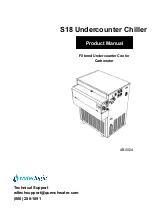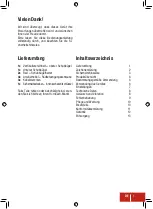
OM WGS-5
WGS 130A to 190A
95
Unit Troubleshooting Chart
!
WARNING
Troubleshooting can cause severe personal injury or death. Troubleshooting must
be performed by trained, experienced technicians only.
PROBLEM
POSSIBLE CAUSES
POSSIBLE CORRECTIVE STEPS
Compressor Will
Not Run
1.
Main switch, circuit breakers open.
2. Fuse
blown.
3.
Thermal overloads tripped or fuses
blown.
4.
Defective contactor or coil.
5.
System shut down by equipment
protection devices.
6.
No cooling required.
7.
Liquid line solenoid will not open.
8.
Motor electrical trouble.
9. Loose
wiring.
1. Close
switch
2.
Check electrical circuits and motor
winding for shorts or grounds.
Investigate for possible overloading.
Replace fuse or reset breakers after fault
is corrected.
3.
Overloads are auto reset. Check unit
closely when unit comes back on line.
4.
Repair or replace.
5.
Determine type and cause of shutdown
and correct it before resetting protection
switch.
6.
None. Wait until unit calls for cooling.
7.
Repair or replace coil.
8.
Check motor for opens, short circuit, or
burnout.
9.
Check all wire junctions. Tighten all
terminal screws.
Compressor
Noisy or Vibrating
1.
Flooding of refrigerant into compressor.
2.
Improper piping support on suction or
liquid line.
3. Worn
compressor.
1.
Check superheat setting of expansion
valve.
2.
Relocate, add or remove hangers.
3. Replace.
High Discharge
Pressure
1.
Condenser water insufficient or
temperature too high.
2.
Fouled condenser tubes (water-cooled
condenser). Clogged spray nozzles
(evaporative condenser). Dirty tube and
fin surface (air cooled condenser).
3.
Noncondensables in system.
4.
System overcharge with refrigerant.
5.
Discharge shutoff valve partially closed.
6.
Condenser undersized (air-cooled).
7.
High ambient conditions.
1.
Readjust temperature control or water
regulating valve. Investigate ways to
increase water supply.
2. Clean.
3.
EPA purge the noncondensables.
4.
Remove excess refrigerant.
5. Open
valve.
6.
Check condenser rating tables against
the operation.
7.
Check condenser rating tables against
the operation.
Low Discharge
Pressure
1.
Faulty condenser temp. regulation.
2.
Insufficient refrigerant in system.
3.
Low suction pressure.
4.
Condenser too large.
5.
Low ambient conditions.
1.
Check condenser control operation.
2.
Check for leaks. Repair and add charge.
3.
See corrective steps for low suction
pressure below.
4.
Check condenser rating table against the
operation.
5.
Check condenser rating tables against
the operation.
High Suction
Pressure
1. Excessive
load.
2.
Expansion valve overfeeding.
1.
Reduce load or add additional
equipment.
2.
Check remote bulb. Regulate superheat.
Continued on next page.
Summary of Contents for WGS130AA: WGS140AW
Page 97: ......




































